Ronchigrams
Scott Prahl
April 2021
[1]:
import numpy as np
import matplotlib.pyplot as plt
import lenstest
%config InlineBackend.figure_format='retina'
Introduction
Ronchigrams are often used in the field of optics to test the quality of mirrors and other optical elements. They can also be used to determine the curvature of a mirror.
To create a ronchigram, you will need the following materials:
A Ronchi grating, characterized by a series of opaque lines with same with as interline spacing
A point source of light source.
A screen or surface to project the ronchigram onto.
A lens or mirror that is the device under test.
If a mirror is being tested then the Ronchi ruling may be placed before or after the focus. When the ruling is after the focus then the layout looks like this
[2]:
D=50
RoC=100
z_offset = 20
lenstest.ronchi.plot_mirror_layout(D, RoC, z_offset)
plt.show()
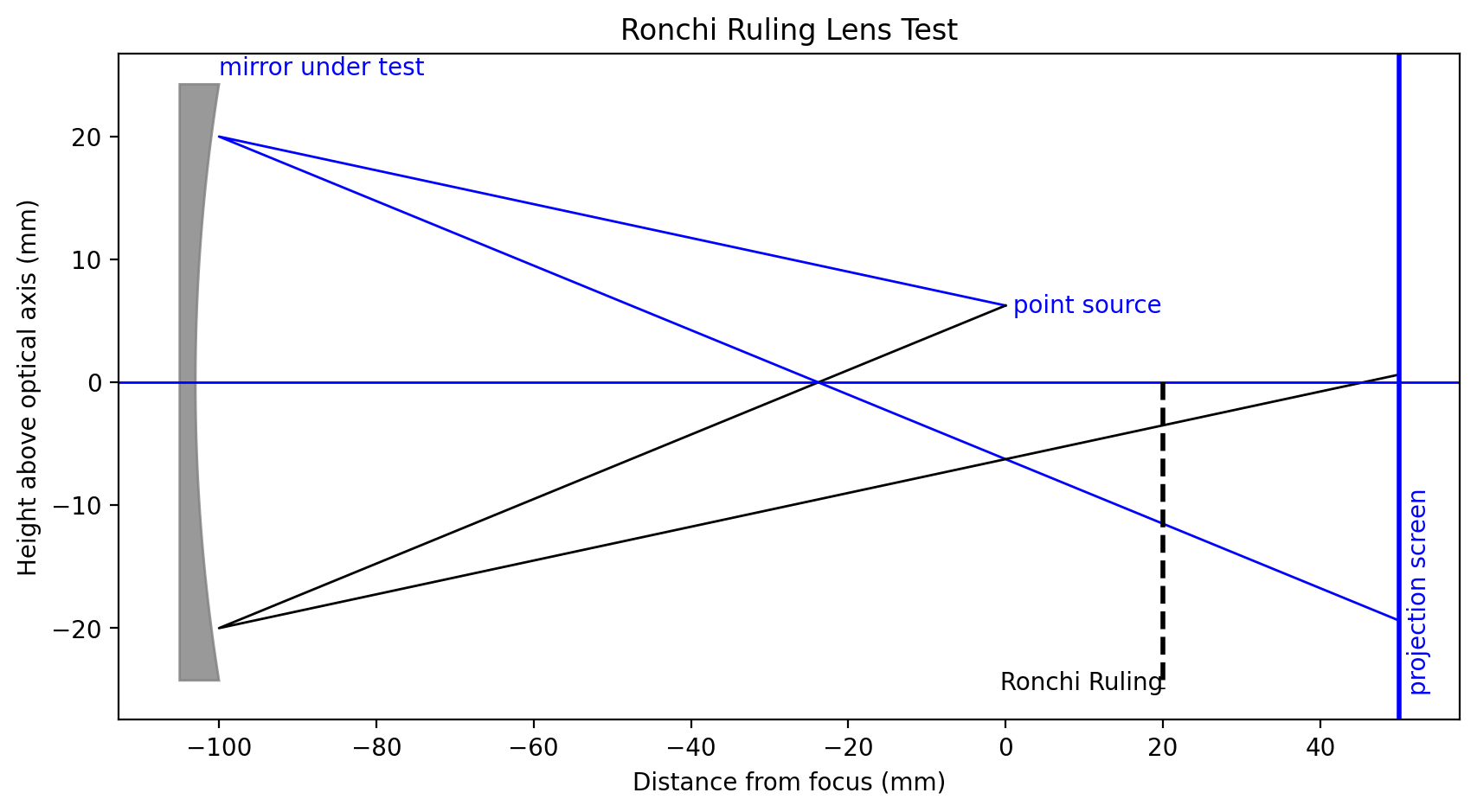
If a lens is being tested, then the layout is a 4f system. Note that the code treats the lens with focal length f as identical to a f=RoC/2 mirror.
[3]:
D=50
RoC=100
z_offset = 20
lenstest.ronchi.plot_lens_layout(D, RoC, z_offset)
plt.show()
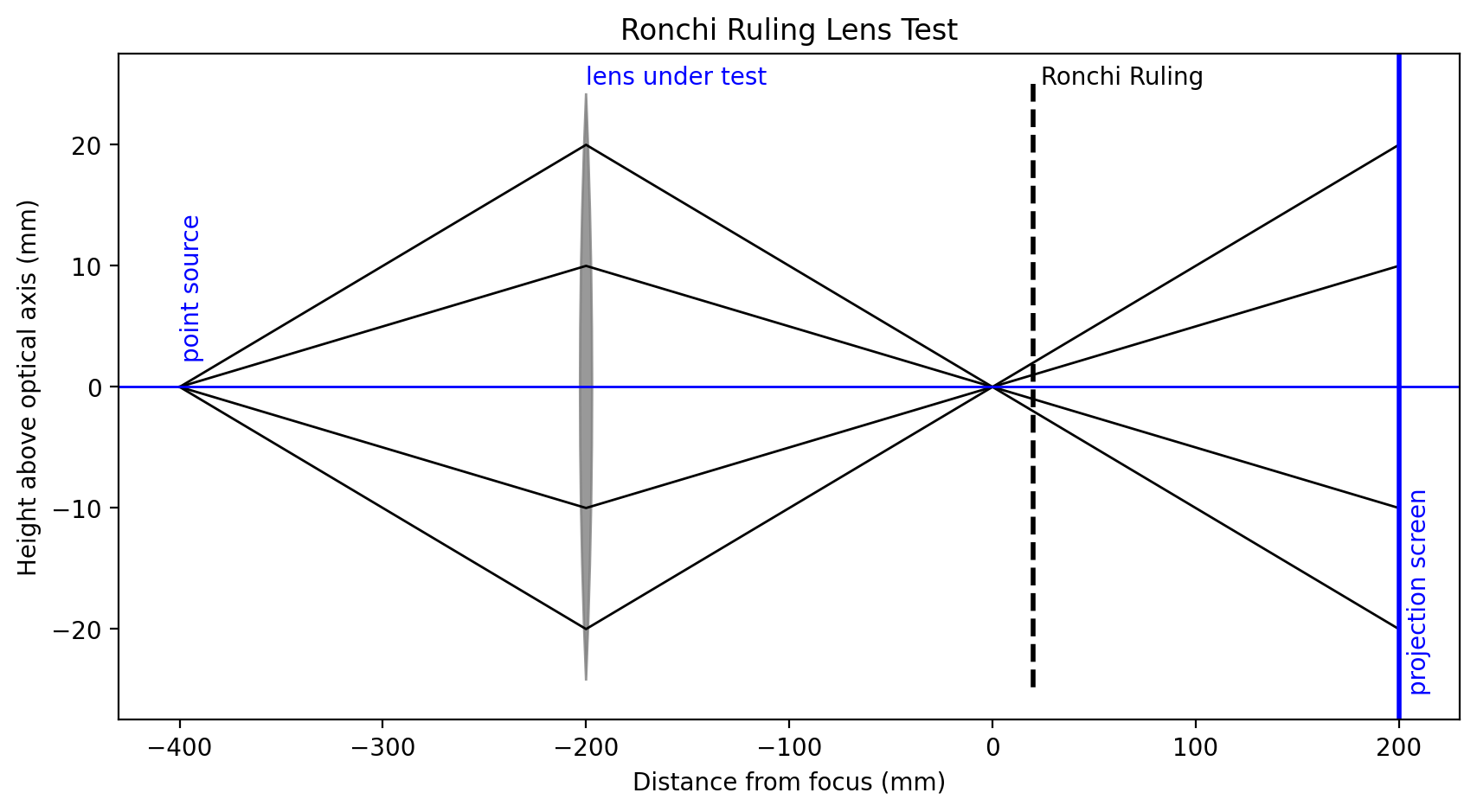
10 inch parabolic mirror comparison
[4]:
conic = -1 # parabolic
D = 10 * 25.4 # mirror diameter [mm]
z_offset = -0.62*25.4 # Ronchi location relative to focus [mm}
RoC = 160 * 25.4 # mm
lines_per_in = 100 # grating freq: (clear + opaque) lines/inch
lp_per_mm = (lines_per_in/2)/25.4 # line pairs per mm
print(" Mirror Diameter = %.3f inches" % (D/25.4))
print(" Focal Length = %.3f inches" % (RoC/25.4/2))
print(" F number = %.3f" % (RoC/2/D))
print(" Radius of curvature = %.3f inches" % (RoC/25.4))
print("Ronchi grating frequency = %.3f line pairs / inch" % (lp_per_mm*25.4))
print(" Ronchi position = %.3f inches after focus" % (z_offset/25.4))
lenstest.ronchi.plot_ruling_and_screen(D, RoC, lp_per_mm, z_offset, conic=conic)
plt.show()
Mirror Diameter = 10.000 inches
Focal Length = 80.000 inches
F number = 8.000
Radius of curvature = 160.000 inches
Ronchi grating frequency = 50.000 line pairs / inch
Ronchi position = -0.620 inches after focus
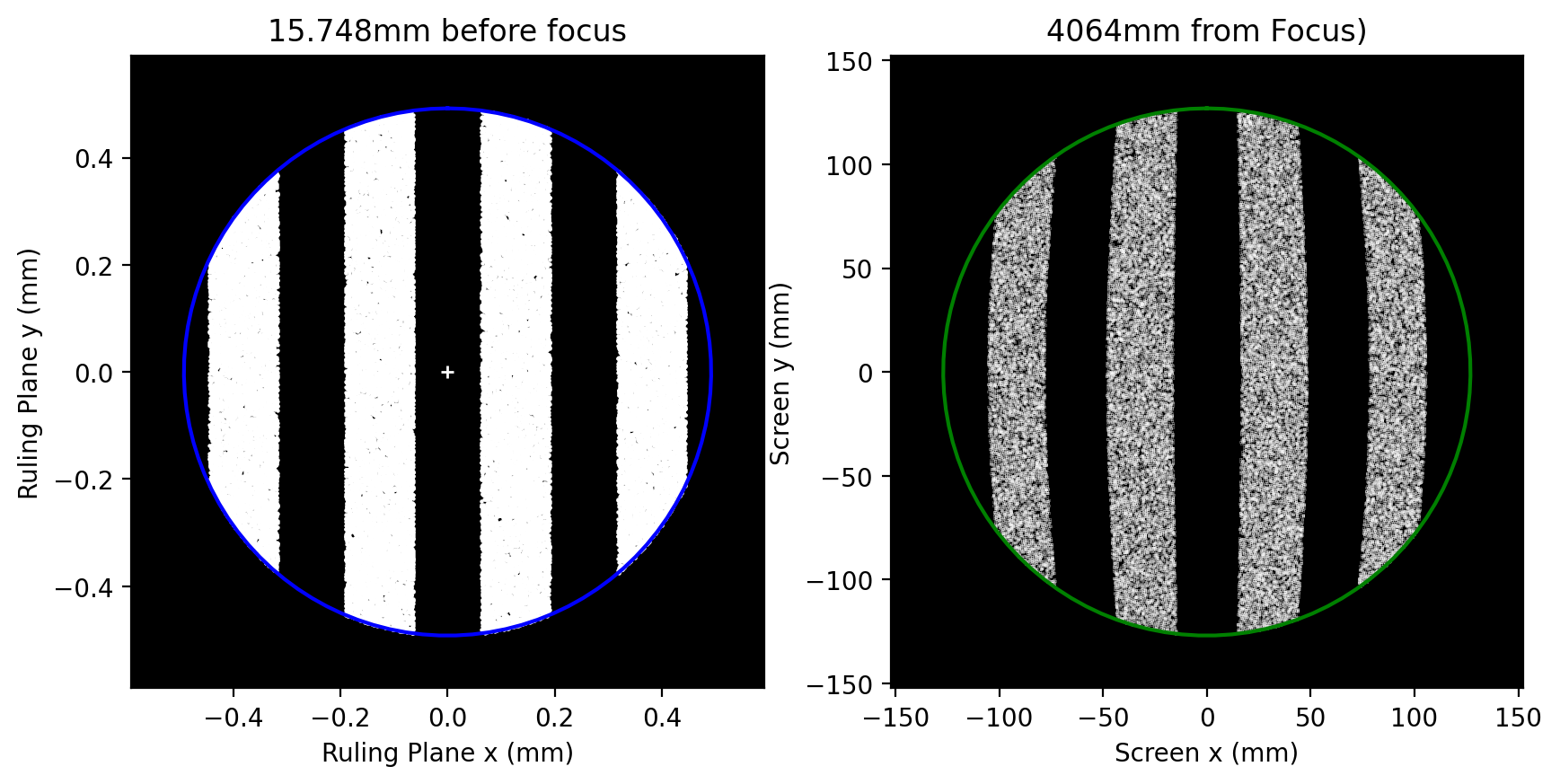
Here is what it should look like

[5]:
# spherical mirror
D = 8000 # 10 meter mirror
F_number = 7
conic = 0
lp_per_mm = 0.133 # grating frequency lp/mm
RoC = F_number * D * 2
f = RoC/2
print(" Mirror Diameter = %.0f mm" % D)
print(" F# = %.1f" % F_number)
print("Radius of Curvature = %.0f mm" % RoC)
print(" Focal Length = %.0f mm" % f)
print(" Ronchi Frequency = %.3f lp/mm" % lp_per_mm)
plt.subplots(2,3,figsize=(13,8))
for i, z_offset in enumerate([-192,-55,82,219,356,493]):
plt.subplot(2,3,i+1)
x,y = lenstest.ronchi.gram(D, RoC, lp_per_mm, z_offset, conic=conic, invert=True)
plt.plot(x,y,'o', markersize=0.1, color='blue')
# for r in [0.37*D/2,0.7*D/2,0.93*D/2]:
# lenstest.lenstest.draw_circle(r, color='red')
lenstest.lenstest.draw_circle(D/2)
plt.title("%.0fmm from focus"%z_offset)
plt.gca().set_aspect("equal")
if i in [1,2,4,5]:
plt.yticks([])
if i in [0,1,2]:
plt.xticks([])
plt.show()
Mirror Diameter = 8000 mm
F# = 7.0
Radius of Curvature = 112000 mm
Focal Length = 56000 mm
Ronchi Frequency = 0.133 lp/mm
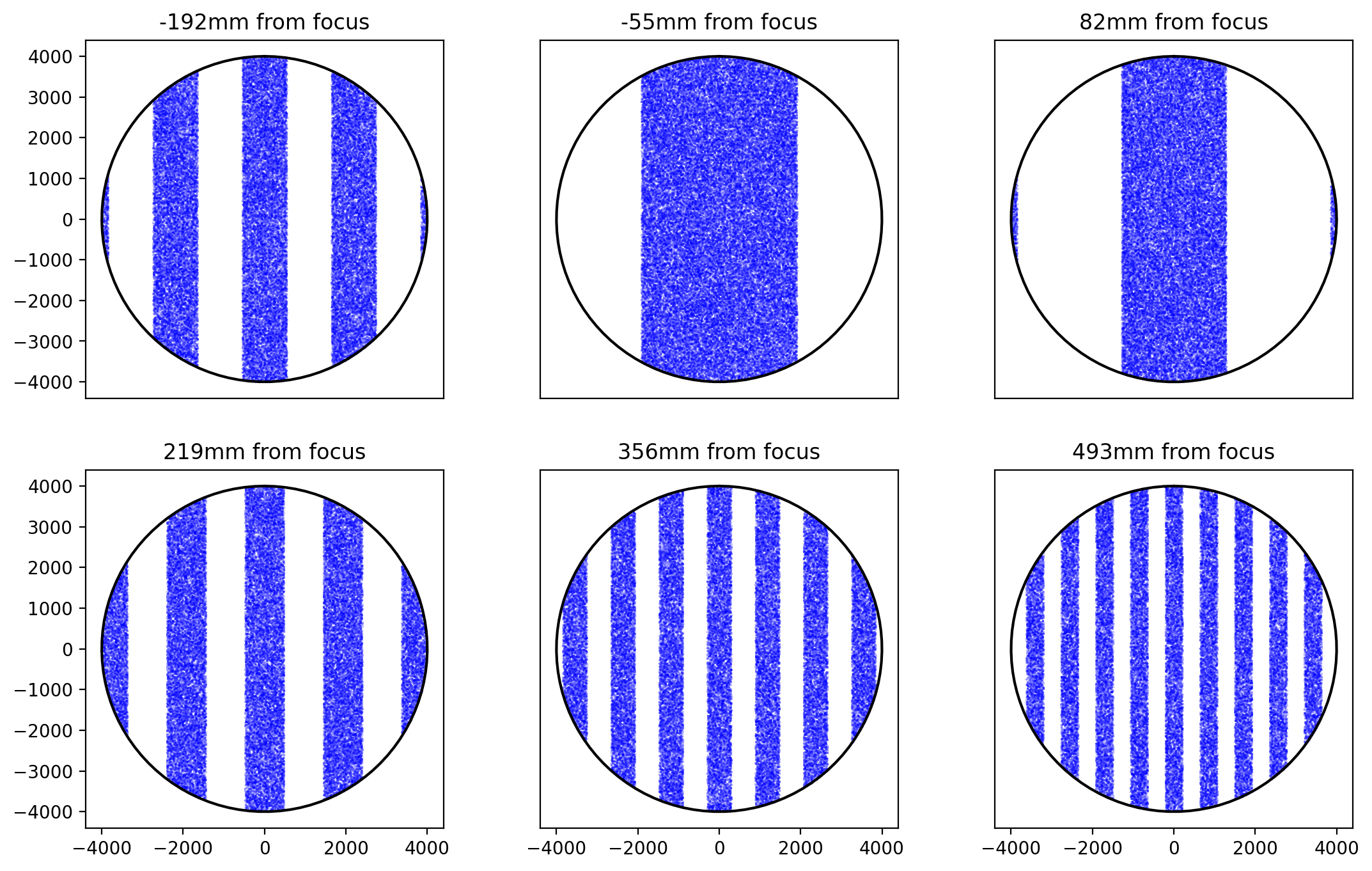
Oblate spheroid
[6]:
# oblate ellipsoid
D = 8000 # 8 meter mirror
F = 7
conic = 1
lp_per_mm = 0.133 # grating frequency lp/mm
RoC = F * D * 2
print(" Mirror Diameter = %.0f mm" % D)
print(" F# = %.1f" % F)
print("Radius of Curvature = %.0f mm" % RoC)
print(" Focal Length = %.0f mm" % (RoC/2))
print(" Ronchi Frequency = %.3f lp/mm" % lp_per_mm)
plt.subplots(2,3,figsize=(13,8))
for i, z_offset in enumerate([-192,-55,82,219,356,493]):
plt.subplot(2,3,i+1)
x,y = lenstest.ronchi.gram(D, RoC, lp_per_mm, z_offset, conic=conic, invert=True)
plt.plot(x,y,'o', markersize=0.1, color='blue')
# for r in [0.37*D/2,0.7*D/2,0.93*D/2]:
# lenstest.lenstest.draw_circle(r, color='red')
lenstest.lenstest.draw_circle(D/2)
plt.title("%.0fmm from focus"%z_offset)
plt.gca().set_aspect("equal")
if i in [1,2,4,5]:
plt.yticks([])
if i in [0,1,2]:
plt.xticks([])
plt.show()
Mirror Diameter = 8000 mm
F# = 7.0
Radius of Curvature = 112000 mm
Focal Length = 56000 mm
Ronchi Frequency = 0.133 lp/mm
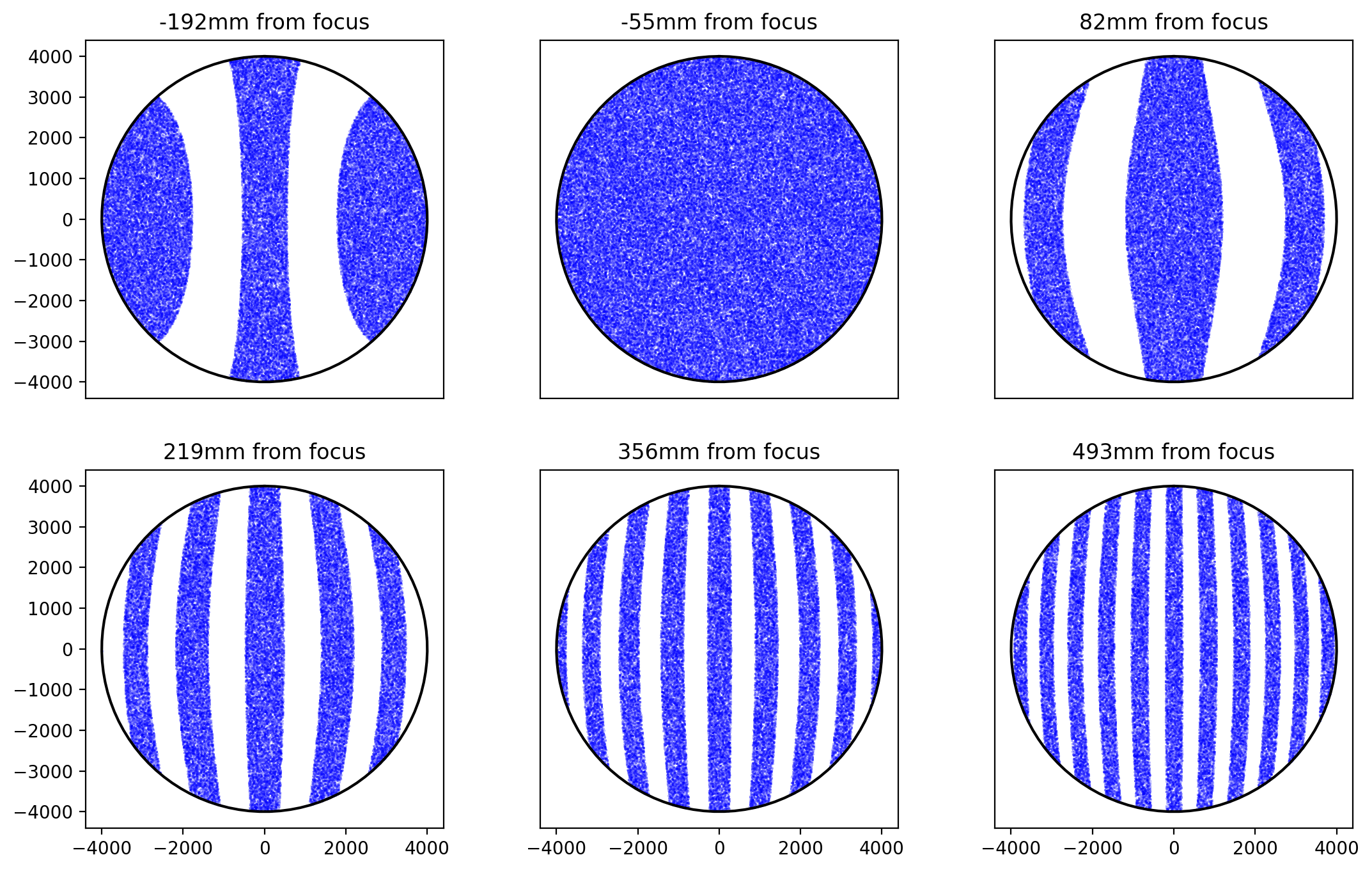
Hyperboloidal mirror
[7]:
D = 8000 # 8 meter mirror
F = 7
conic = 2
lp_per_mm = 0.133 # grating frequency lp/mm
RoC = F * D * 2
print(" Mirror Diameter = %.0f mm" % D)
print(" F# = %.1f" % F)
print("Radius of Curvature = %.0f mm" % RoC)
print(" Focal Length = %.0f mm" % (RoC/2))
print(" Ronchi Frequency = %.3f lp/mm" % lp_per_mm)
plt.subplots(2,3,figsize=(13,8))
for i, z_offset in enumerate([-192,-55,82,219,356,493]):
plt.subplot(2,3,i+1)
x,y = lenstest.ronchi.gram(D, RoC, lp_per_mm, z_offset, conic=conic, invert=True)
plt.plot(x,y,'o', markersize=0.1, color='blue')
# for r in [0.37*D/2,0.7*D/2,0.93*D/2]:
# lenstest.lenstest.draw_circle(r, color='red')
lenstest.lenstest.draw_circle(D/2)
plt.title("%.0fmm from focus"%z_offset)
plt.gca().set_aspect("equal")
if i in [1,2,4,5]:
plt.yticks([])
if i in [0,1,2]:
plt.xticks([])
plt.show()
Mirror Diameter = 8000 mm
F# = 7.0
Radius of Curvature = 112000 mm
Focal Length = 56000 mm
Ronchi Frequency = 0.133 lp/mm
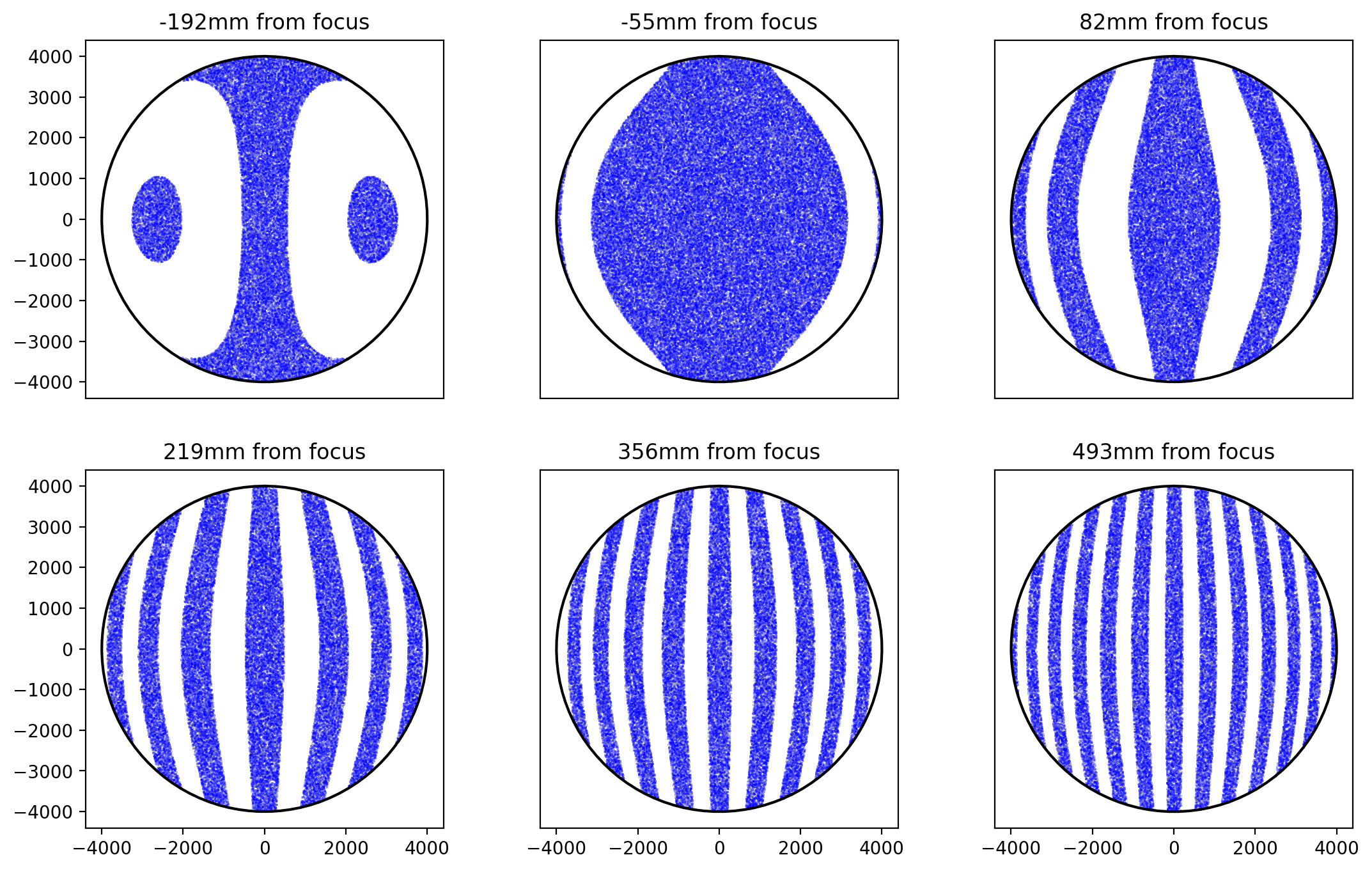
10 meter parabolic mirror comparison
Ronchigrams passing through focus
Here are six ronchigrams at different locations inside and outside the focus.
[8]:
D = 10000 # 10 meter mirror
F = 5
conic = -1
lp_per_mm = 0.133 # grating frequency lp/mm
RoC = F * D * 2
print(" Mirror Diameter = %.0f mm" % D)
print(" F# = %.1f" % F)
print("Radius of Curvature = %.0f mm" % RoC)
print(" Focal Length = %.0f mm" % (RoC/2))
print(" Ronchi Frequency = %.3f lp/mm" % lp_per_mm)
plt.subplots(2,3,figsize=(13,8))
for i, z_offset in enumerate([-63,35,133,231,329,429]):
plt.subplot(2,3,i+1)
x,y = lenstest.ronchi.gram(D, RoC, lp_per_mm, z_offset, conic=conic)
plt.plot(x,y,'o', markersize=0.1, color='blue')
# for r in [0.37*D/2,0.7*D/2,0.93*D/2]:
# lenstest.lenstest.draw_circle(r, color='red')
lenstest.lenstest.draw_circle(D/2)
plt.title("%.0fmm from focus"%z_offset)
plt.gca().set_aspect("equal")
if i in [1,2,4,5]:
plt.yticks([])
if i in [0,1,2]:
plt.xticks([])
plt.show()
Mirror Diameter = 10000 mm
F# = 5.0
Radius of Curvature = 100000 mm
Focal Length = 50000 mm
Ronchi Frequency = 0.133 lp/mm
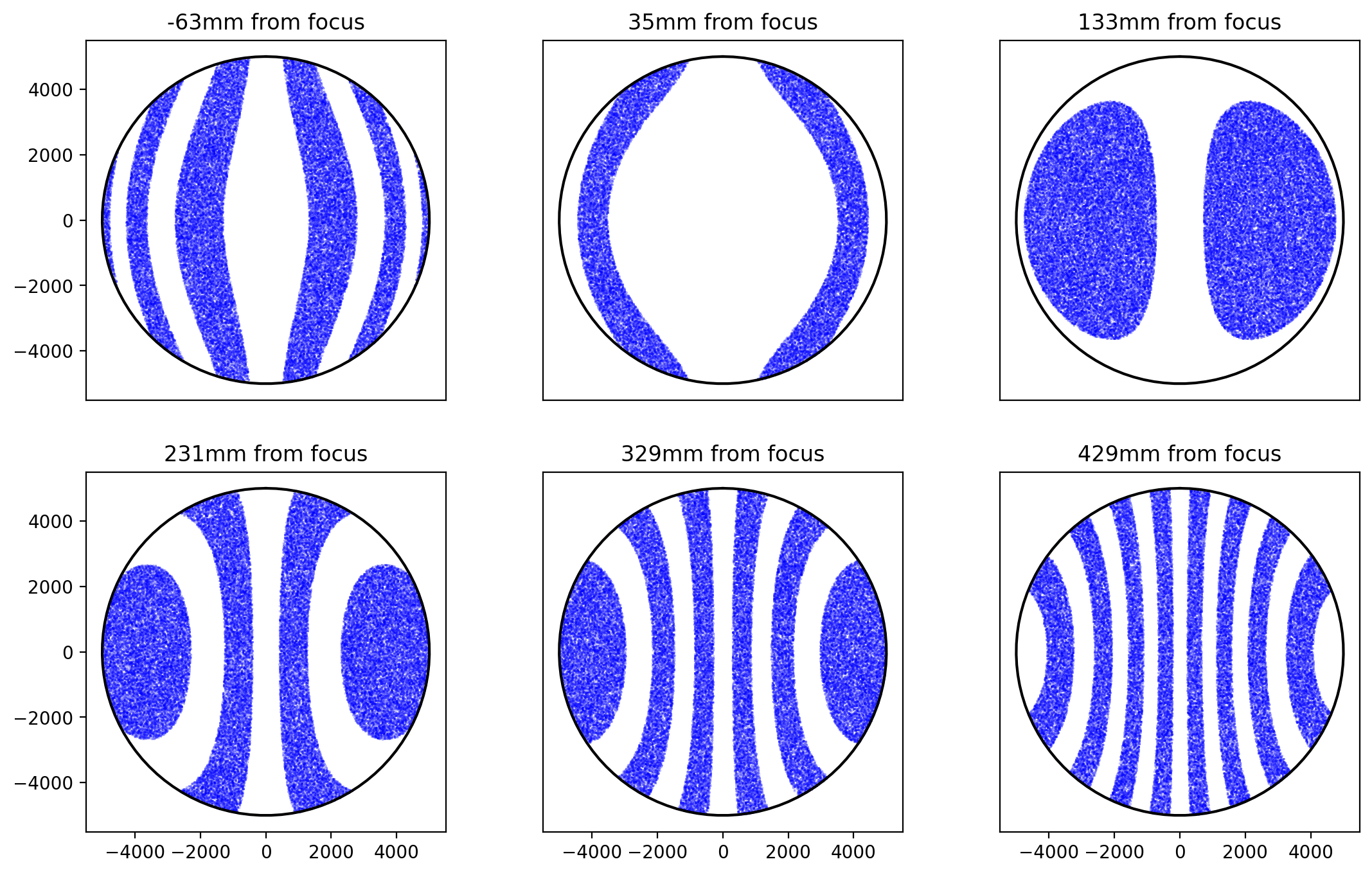
We an compare this to figure 2 from Upton’s page on simulating the Ronchi test
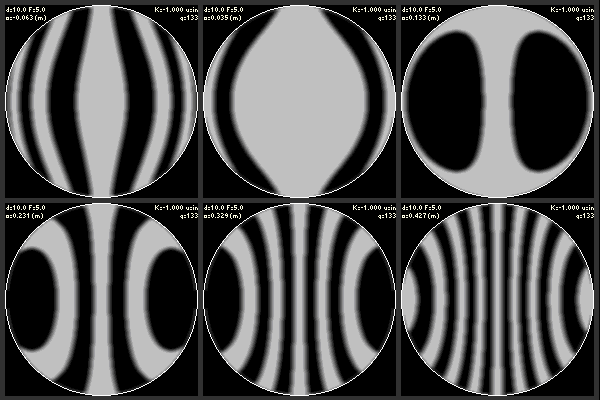
[ ]: